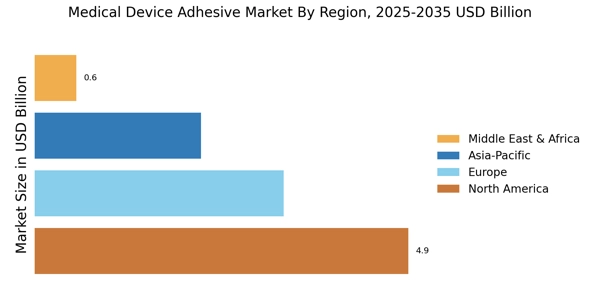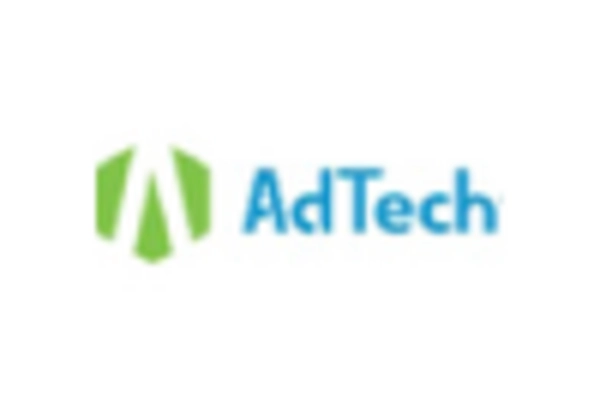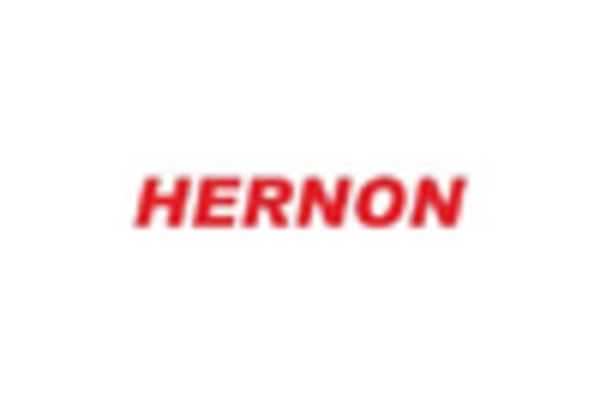Expansion of the Medical Device Market
The expansion of the medical device market is a significant driver for the Medical Device Adhesive Market. As the healthcare sector continues to evolve, the demand for a wide array of medical devices, including diagnostic tools, surgical instruments, and wearable technologies, is on the rise. This growth is projected to propel the adhesive market, with estimates suggesting a compound annual growth rate of around 6% through 2027. The increasing complexity of medical devices necessitates the use of specialized adhesives that can provide reliable bonding under various conditions. Furthermore, the trend towards minimally invasive procedures is driving the need for adhesives that can facilitate secure device attachment without compromising patient safety. This dynamic environment presents substantial opportunities for manufacturers to innovate and expand their product offerings within the Medical Device Adhesive Market.
Increasing Focus on Patient-Centric Healthcare
The Medical Device Adhesive Market is increasingly shaped by a focus on patient-centric healthcare. This paradigm shift emphasizes the importance of patient comfort, safety, and satisfaction in medical treatments. As healthcare providers prioritize patient outcomes, the demand for adhesives that minimize discomfort and promote healing is on the rise. Market analysis indicates that patient-centric products are likely to capture a larger share of the adhesive market, with projections suggesting a growth trajectory of approximately 5% annually. Additionally, the integration of patient feedback into product development processes is becoming more prevalent, leading to the creation of adhesives that cater specifically to patient needs. This trend not only enhances the overall patient experience but also drives innovation within the Medical Device Adhesive Market, as manufacturers strive to meet evolving consumer expectations.
Rising Demand for Advanced Wound Care Solutions
The Medical Device Adhesive Market is experiencing a notable increase in demand for advanced wound care solutions. This trend is driven by the growing prevalence of chronic wounds and surgical procedures that require effective adhesion. According to recent data, the market for wound care adhesives is projected to reach USD 3 billion by 2026, reflecting a compound annual growth rate of approximately 6.5%. The need for adhesives that provide secure bonding while being gentle on the skin is paramount, as healthcare providers seek to enhance patient comfort and recovery times. Furthermore, the shift towards home healthcare solutions necessitates the development of user-friendly adhesive products that can be easily applied by patients or caregivers. This evolving landscape indicates a robust opportunity for innovation within the Medical Device Adhesive Market.
Technological Advancements in Adhesive Formulations
Technological advancements in adhesive formulations are significantly influencing the Medical Device Adhesive Market. Innovations in polymer chemistry and material science have led to the development of high-performance adhesives that offer superior bonding capabilities and biocompatibility. For instance, the introduction of pressure-sensitive adhesives and bio-adhesives has expanded the application range of medical adhesives, catering to diverse medical devices. The market is expected to witness a surge in the adoption of these advanced formulations, with estimates suggesting a growth rate of around 7% annually over the next five years. These advancements not only enhance the performance of medical devices but also align with the increasing regulatory demands for safety and efficacy in medical products. As a result, manufacturers are compelled to invest in research and development to stay competitive in the Medical Device Adhesive Market.
Regulatory Support for Innovative Adhesive Solutions
Regulatory support for innovative adhesive solutions is a critical driver in the Medical Device Adhesive Market. Regulatory bodies are increasingly recognizing the importance of advanced adhesive technologies in improving medical device performance and patient outcomes. This support is evident in the streamlined approval processes for novel adhesive products, which encourages manufacturers to invest in research and development. Recent initiatives have been introduced to facilitate faster market entry for innovative adhesives, particularly those that demonstrate enhanced safety and efficacy. As a result, the market is poised for growth, with estimates indicating a potential increase in market size by 8% over the next few years. This regulatory environment not only fosters innovation but also ensures that new products meet stringent safety standards, thereby enhancing consumer trust in the Medical Device Adhesive Market.


















Leave a Comment